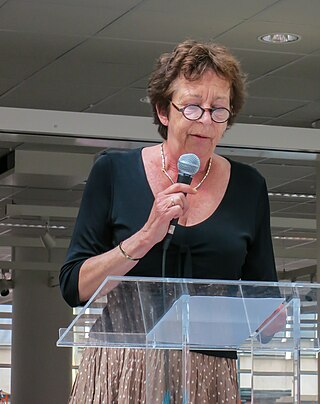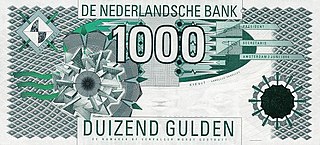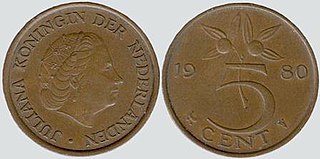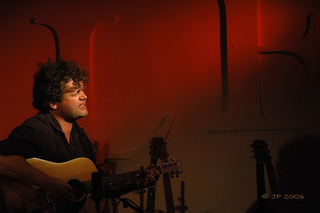
The compact disc (CD) is a digital optical disc data storage format that was co-developed by Philips and Sony to store and play digital audio recordings. It uses the Compact Disc Digital Audio format which typically provides 74 minutes of audio on a disc. In later years, the compact disc was adapted for non-audio computer data storage purposes as CD-ROM and its derivatives. First released in Japan in October 1982, the CD was the second optical disc technology to be invented, after the much larger LaserDisc (LD). By 2007, 200 billion CDs had been sold worldwide.

A thaler or taler is one of the large silver coins minted in the states and territories of the Holy Roman Empire and the Habsburg monarchy during the Early Modern period. A thaler size silver coin has a diameter of about 40 mm and a weight of about 25 to 30 grams. The word is shortened from Joachimsthaler, the original thaler coin minted in Joachimsthal, Bohemia, from 1520.

The Osdorp Posse, founded in Amsterdam, Netherlands, in 1989, was the first group to make rap music in Dutch. All four members are related to each other. Influenced by gangsta rap, they made a name for themselves by combining the music of hardcore hip hop with Dutch lyrics featuring literal translations of American slang. Initially appreciated only in the Dutch underground scene, they achieved commercial success and exerted great influence on the Dutch hip hop scene.

Renate Maria Dorrestein was a Dutch writer, journalist and feminist. She started working as a junior journalist for the Dutch magazines Libelle and Panorama. During the period 1977 - 1982 she published in Het Parool, Viva, Onkruid and Opzij. Dorrestein published her first novel (Buitenstaanders) in 1983. Her sister's suicide had a great influence on her books. Dorrestein won the Annie Romein prize in 1993 for her complete body of work. A lot of Dorrestein's books were translated, and they were sold in 14 countries.

The guilder or florin was the currency of the Netherlands from 1434 until 2002, when it was replaced by the euro.

The stuiver was a coin used in the Netherlands, worth 1⁄20 of a guilder. It was also minted on the Lower Rhine region and the Dutch colonies. The word can still refer to the 5 euro cent coin, which has almost exactly the same diameter and colour despite being over twice the value of the older coin.

The Netherlands Antillean guilder is the currency of Curaçao and Sint Maarten, which until 2010 formed the Netherlands Antilles along with Bonaire, Saba, and Sint Eustatius. It is subdivided into 100 cents. The guilder was replaced on 1 January 2011 on the islands of Bonaire, Saba and Sint Eustatius by the United States dollar.

The duit was an old low-value Dutch copper coin. Struck in the 17th and 18th centuries in the territory of the Dutch Republic, it became an international currency. It had the value of 1/8 stuiver.

The rijksdaalder was a Dutch coin first issued by the Republic of the Seven United Netherlands in the late 16th century during the Dutch Revolt which featured an armored half bust of William the Silent. It was the Dutch counterpart of the Reichsthaler of the Holy Roman Empire but weighed slightly less, at 29.03 g of 0.885 fine silver, reduced to 0.875 fine by the 17th century. Friesland, Gelderland, Holland, Kampen, Overijssel, Utrecht, West Friesland, Zeeland, and Zwolle minted armored half bust rijksdaalders until the end of the 17th century.

The Netherlands Indies guilder was the unit of account of the Dutch East Indies from 1602 under the United East India Company, following Dutch practice first adopted in the 15th century. A variety of Dutch, Spanish and Asian coins were in official and common usage. After the collapse of the VOC at the end of the 18th century, control of the islands reverted to the Dutch government, which issued silver 'Netherlands Indies' guilder and fractional silver and copper coins until Indonesian independence in 1945.
The Golden Film is a film award recognizing domestic box office achievements in the Netherlands. The Golden Film is awarded to films from the Netherlands once they have sold 100,000 tickets. The award is an initiative by the Netherlands Film Festival and the Netherlands Film Fund to increase media attention for Dutch films. For each awarded film there is one trophy for the film crew and another for the film cast.
The Diamond Film is a film award recognising domestic box office achievements in the Netherlands. The Diamond Film is awarded to films from the Netherlands once they have sold 1,000,000 cinema tickets or more during the original circulation. The award is initiated by the Netherlands Film Festival and the Netherlands Film Fund in addition to the Golden Film for 100,000 visitors, the Platinum Film for 400,000 visitors, and the Crystal Film for 10,000 visitors of a documentary film.

The Philips Natuurkundig Laboratorium or NatLab was the Dutch section of the Philips research department, which did research for the product divisions of that company.

The twenty-five cent was a coin worth a quarter of decimal Dutch guilder. It was used from the decimalisation of the currency in 1817 until the Netherlands adopted the euro as sole currency in 2002. The last minting was in 2001. The coin was the third-smallest denomination of the guilder when the currency was withdrawn, and the largest of a value less than one guilder.

Oei Oei Oei (Dat Was Me Weer Een Loei) is a song by Johan Cruyff. It is the only song the association football star ever released, and it was written by Peter Koelewijn.

The Five cent coin was a coin struck in the Kingdom of the Netherlands between 1818 and 2001. Twenty stuivers equalled a Dutch Guilder.

Skik is a Dutch pop group, originating from the town of Erica, Drenthe. The band mainly sings in Drèents, a variation of Low-Saxon, which is traditionally spoken in Drenthe. Skik is Drèents for fun or enjoyment.
Ecotribe Teuge is a collective of people living on a squatted terrain in the Dutch countryside. It is located on the edge of the village of Teuge, in the province of Gelderland. The buildings were constructed by the Nazis and formerly used to house Moluccan soldiers. The site was occupied in 2001, when people began to live there in an off-the-grid and self-sufficient manner. Since 2018, there are plans by the province to develop the terrain.

Big Brother is the Dutch & Belgian cooperation version of the international reality television franchise Big Brother produced by Endemol. The show aired in Netherlands on RTL5 and in the Flemish Region on VIER/Play4 and has had a total of three seasons. The first season of the show aired in 2021. A fourth season will air in 2024.




















